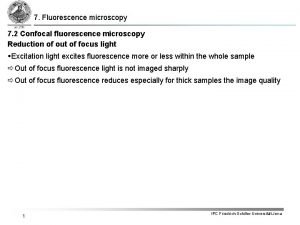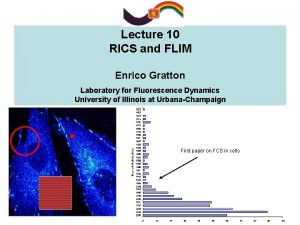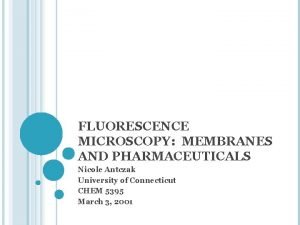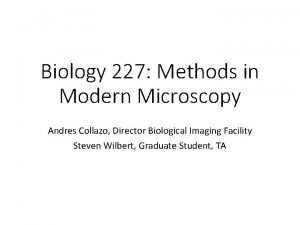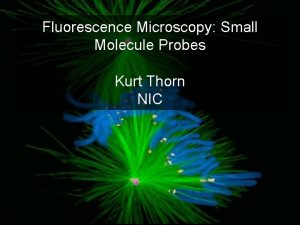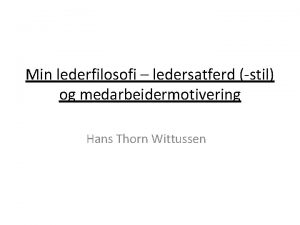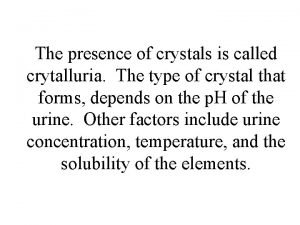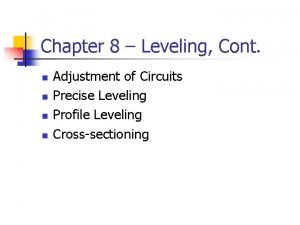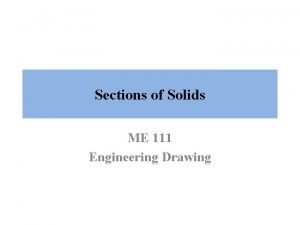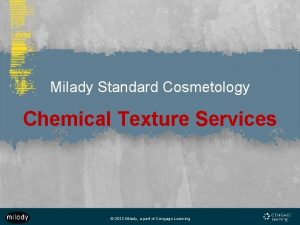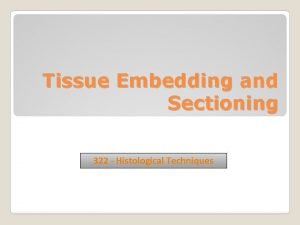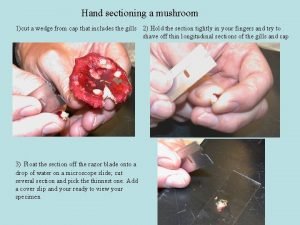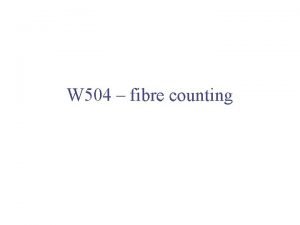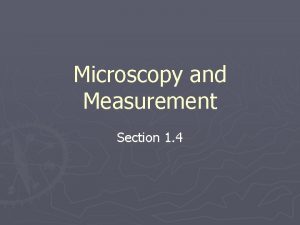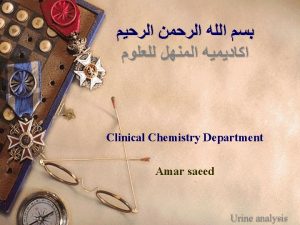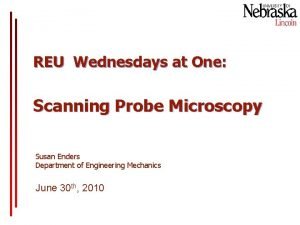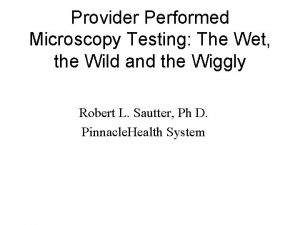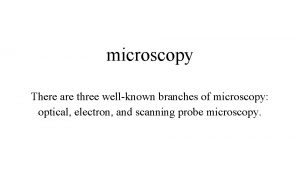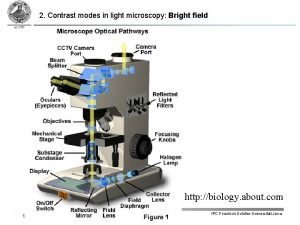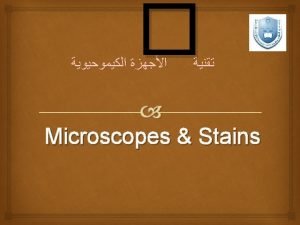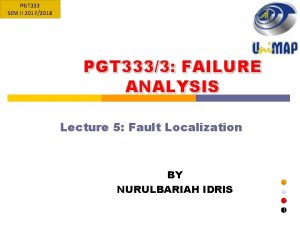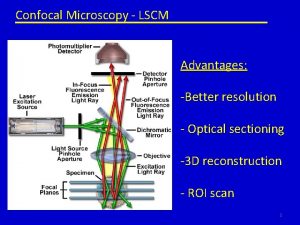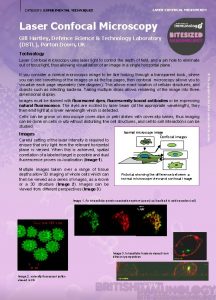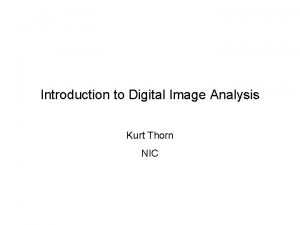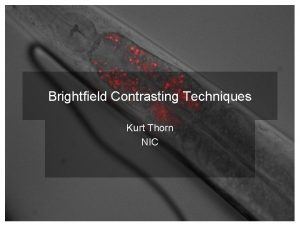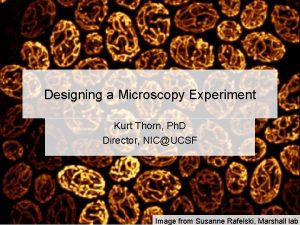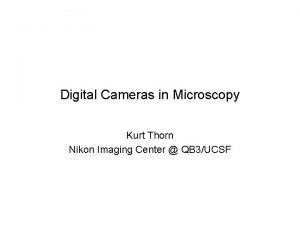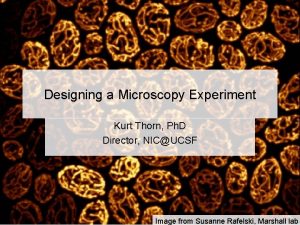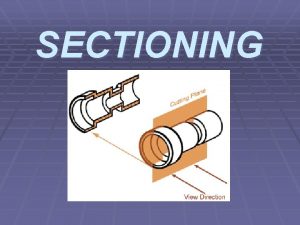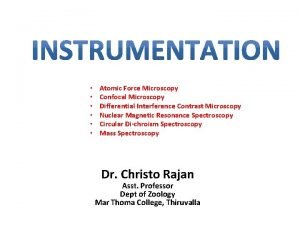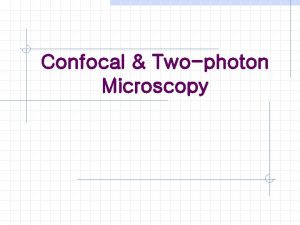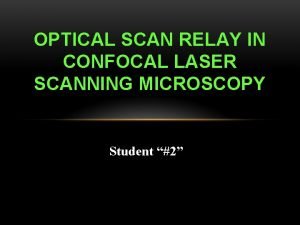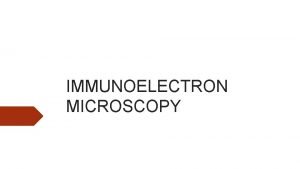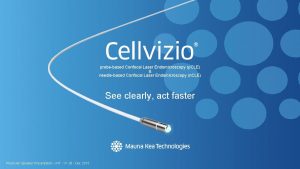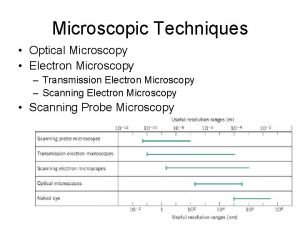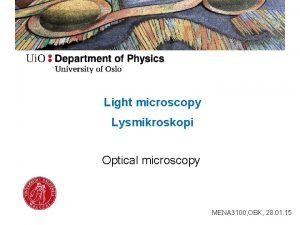Confocal Microscopy Kurt Thorn NIC Optical Sectioning and

















































- Slides: 49

Confocal Microscopy Kurt Thorn NIC

Optical Sectioning and 3 D reconstruction z x y

Optical Sectioning and 3 D reconstruction z x y

Optical Sectioning and 3 D reconstruction = z x y

Optical Sectioning and 3 D reconstruction C. elegans with two different sensory neurons expressing GFP, Ds. Red Swept-Field Confocal, 85 Z slices, 250 nm spacing

Optical Sectioning and 3 D reconstruction

Fluorescence Illumination of a single point Camera Tube lens Excitation light Emission light Objective lens Sample Problem – fluorescence is emitted along entire illuminated cone, not just at focus

Widefield fluorescence imaging Widefield Illumination Point Illumination

The Point Spread Function (PSF) The image of a point object 2 D PSF for different defocus Z=+2µm 3 D PSF Calculated z Z=0 y Z=-2µm x x Measured


The confocal microscope Scan excitation spot pointby-point to build up image Detector Pinhole Tube lens Emission light Objective lens Sample Excitation light

How big should your pinhole be? Resolution is limited by the point-spread function Y X Airy disk radius ≈ 0. 61 /NA Z

How big should your pinhole be? Want pinhole to pass entire Airy disk Y X Airy disk diameter ≈ 1. 22 /NA Width of point spread function at pinhole: Airy disk diameter × magnification of lens

How big should your pinhole be? • Width of point spread function at pinhole = Airy disk diameter × magnification of lens = 1 Airy unit = resolution of lens × magnification of lens × 2 – 100 x / 1. 4 NA: resolution = 220 nm, so 1 Airy unit = 44 mm – 40 x / 1. 3 NA: resolution = 235 nm, so 1 Airy unit = 19 mm – 20 x / 0. 75 NA: resolution = 407 nm, so 1 Airy unit = 16 mm – 10 x / 0. 45 NA: resolution = 678 nm, so 1 Airy unit = 14 mm

Pinhole size • C 1 si: 30, 60, 100, 150 mm • Spinning Disk: 50 mm • All are substantially larger than Airy Disk for low magnification lenses. – On spinning disk, can use 1. 5 x magnification changer

Light sources Excitation light must be focused to a diffraction limited spot Could be done with an arc lamp and pinhole – but very inefficient Enter the laser: Perfectly collimated and high power Excitation light Objective lens Sample

Scanning Changing entrance angle of illumination moves illumination spot on sample Objective lens Sample The emission spot moves, so we have to make sure pinhole is coincident with it

Confocal optical path Scanning mirrors Dichroic x Detector y Relay lens Objective Pinhole Laser

C 1 si internals

What do you get?

Detectors - PMTs • Must be fast – confocal beam spends only a few ms on each pixel – Photomultiplier tubes Pulse width for single photon ~ 10 -100 ns Very linear Very high gain ~ 0 read noise

Detectors - PMTs

Laser-Scanning Confocal E 11. 5 mouse lung stained for E-cadherin Nan Tang, Martin lab

Confocal vs. Widefield Confocal Tissue culture cell with 60 x / 1. 4 NA objective Widefield

Confocal vs. Widefield Confocal Widefield 20 mm rat intestine section recorded with 60 x / 1. 4 NA objective

Multi-photon excitation Internal conversion S 1 h A h E h A S 0 2 1 0 Brad Amos, MRC, Cambridge Multi-photon excitation does not excite out-of-focus light, so you can get rid of pinhole

Spectral Detection Montage of 32 channels of sample stained with DAPI and Alexa 488

Spectral Confocal

Autofluorescence removal Drosophila embryo with neuronal GFP staining – Jan lab Best single channel image After autofluorescence removal by linear unmixing

The confocal microscope Scan excitation spot pointby-point to build up image Detector Pinhole Tube lens Emission light Objective lens Sample Excitation light Problems: Slow (~1 sec to acquire an image) Low light efficiency (due to use of PMT as detector) Solution: Use multiple pinholes and a camera

A Solution: Spinning Disk Confocal Image with many pinholes at once, so fast Use CCD as detector, so much higher QE

Pros/Cons of spinning disk • Fast – multiple points are illuminated at once • Photon efficient – high QE of CCD • Gentler on live samples – usually lower laser power • Fixed pinhole – except in swept-field • Small field of view (usually) • Crosstalk through adjacent pinholes limits sample thickness

Out-of-focus rejection T Defocus Wolleschensky et al. J. Biomed. Opt. 11(6) 2006

Examples Drosophila S 2 cell expressing GFP-H 2 B and m. Cherry-tubulin (Nico Stuurman and Ron Vale) S. cerevisiae expressing a mitochondrially targeted RFP, Susanne Rafelski, Marshall lab

Which imaging technique should I use? 1 -5 mm TIRF (for samples at the coverslip) Spinning Disk Confocal Line-scanning confocal >20 mm Point scanning Confocal >50 -100 mm 2 -photon confocal Slow 10 -100 mm Sensitivity Sample Thickness 1 -20 mm Fast Wide-field (+deconvolution)

When to use confocal? • Confocal is not a magic bullet – It is extremely wasteful of photons – Laser-scanning confocal is 100 – 200 -fold less sensitive than widefield – Spinning-disk confocal is ~4 -fold less sensitive than widefield

When to use confocal? • Confocal is not a magic bullet – It is extremely wasteful of photons – High laser power generally result in more photobleaching and photodamage. • For thin specimens, widefield epifluorescence is better – especially with deconvolution • Confocal excels with thick, heavily stained specimens

When to use confocal? • What is thick? – A good rule of thumb is 10 × the depth of field of the objective – 100 x / 1. 4 NA: d. o. f. 0. 66 mm – 20 x / 0. 75 NA: d. o. f 2. 3 mm • Sample preparation is KEY for imaging thick specimens – Confocal does not fix scattering, refractive index mismatch, or everything else that can go wrong – it only removes out of focus light

Sample preparation • For fixed samples: match refractive index of mounting media to immersion oil. – Mount in immersion oil itself, BABB, benzyl alcohol/glycerol, 2, 2’-thiodiethanol, or other high. RI mounting medium • Clearing to remove lipids and other scattering substances is also important • For live samples, use water immersion lenses

Spherical Aberration Point spread functions Ideal 1 wave of spherical ab x x z

Sources of Spherical Aberration Design compromises Manufacturing tolerances Immersion fluid index error Temperature variation Cover slip thickness (high-NA objectives except oil immersion) Correction collar setting Sample refractive index mismatch

Index Mismatch & Spherical Aberration objective Immersion fluid n 1 Cover glass n 2 Sample Focus at cover slip Focus into sample Spherical aberration unless n 2 = n 1

Index Mismatch & Spherical Aberration z=0 µm n 1=1. 515 (oil) z=25 µm n 2=1. 44 (Vectashield) z=50 µm

Index Mismatch & Axial Scaling n 1 n 2 Mechanical focus step zm If there is index mismatch, your z pixel size is not what you think Optical focus step zo

Getting Rid of Spherical Aberration • Use correct and consistent cover slips • Pick a room with stable temperature ≈ 20°C • Adjust correction collar • If no collar, adjust immersion medium index • Use an objective that is matched to the mounting medium: • For aqueous samples, use a water immersion objective • For fixed samples viewed with oil immersion objectives, ideally use a mounting medium with index ≈ 1. 515 • For fixed samples in commercial media, ideally use a glycerol immersion objective

Sample Preparation Samples imaged with 20 x / 0. 75 air objective on spectral confocal Sections acquired ~ 50 mm into tissue Embryonic mouse lungs; samples from Nan Tang, Martin Lab

Sample Preparation Samples imaged with 40 x / 1. 3 oil objective on spectral confocal Sections acquired ~ 50 mm into tissue Embryonic mouse lungs; samples from Nan Tang, Martin Lab

Clearing and mounting summary • Both clearing and refractive index matching are important. • BABB and methyl salicylate clear very well and give best image depth, but may disrupt cell morphology • TDE preserves cell morphology and also allows for decent imaging depth

Slides can be downloaded from: http: //nic. ucsf. edu/dokuwiki/doku. php? id=presentations Resources http: //www. microscopyu. com http: //micro. magnet. fsu. edu James Pawley, Ed. “Handbook of Biological Confocal Microscopy, 3 rd ed. ” Murray JM et al. , J. Microsc. 2007, 228: p. 390 -405 Acknowledgements Steve Ross, Mats Gustafsson
 Confocal fluorescence microscopy
Confocal fluorescence microscopy Laser confocal microscopy
Laser confocal microscopy Laser confocal microscopy
Laser confocal microscopy Laser confocal microscopy
Laser confocal microscopy Kurt thorn
Kurt thorn Tropical thorn forests and scrubs
Tropical thorn forests and scrubs Tropical thorn forest and scrubs
Tropical thorn forest and scrubs Spine vs thorn
Spine vs thorn Silver thorn of bloody rose
Silver thorn of bloody rose Thorn slimste mens
Thorn slimste mens John agard checking out me history
John agard checking out me history Frameless heads on nameless walls
Frameless heads on nameless walls Hans thorn wittussen
Hans thorn wittussen Coniferous forest location in pakistan
Coniferous forest location in pakistan Jane thorn
Jane thorn Rose/thorn virtual icebreaker
Rose/thorn virtual icebreaker Crytalluria
Crytalluria Thorn the disciples angel
Thorn the disciples angel Cont nn
Cont nn What is meant by true shape of section
What is meant by true shape of section Revolved section view
Revolved section view Removed section view
Removed section view Section lining symbols
Section lining symbols Permanent waving milady
Permanent waving milady Half section views
Half section views Technical drawing section view
Technical drawing section view The main purpose of the sectioning is to
The main purpose of the sectioning is to Sectioning in tissue processing
Sectioning in tissue processing Sectional plane are represented by
Sectional plane are represented by Sectioning of solids
Sectioning of solids Sectioning
Sectioning Frame rail sectioning procedures
Frame rail sectioning procedures Matrices and wedges
Matrices and wedges Hand sectioning
Hand sectioning Disadvantage of phase contrast microscopy
Disadvantage of phase contrast microscopy Microscopy and measurement section 1-4 review
Microscopy and measurement section 1-4 review Selective medium for vibrio cholerae
Selective medium for vibrio cholerae Microscopic analysis of urine
Microscopic analysis of urine Advantages of scanning probe microscopy
Advantages of scanning probe microscopy Provider-performed microscopy test examples
Provider-performed microscopy test examples Oa module
Oa module Branches of microscopy
Branches of microscopy Centrifuged
Centrifuged What is forensic microscopy
What is forensic microscopy Magnetic force microscopy data recovery
Magnetic force microscopy data recovery Alzheimer's disease microscopy
Alzheimer's disease microscopy Dic microscopy vs phase contrast
Dic microscopy vs phase contrast Bright field microscopy
Bright field microscopy 1674 microscopy
1674 microscopy Photo emission microscopy failure analysis
Photo emission microscopy failure analysis
